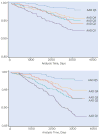Proximal aortic distensibility is an independent predictor of all-cause mortality and incident CV events: the MESA study
- PMID: 25524341
- PMCID: PMC4273646
- DOI: 10.1016/j.jacc.2014.09.060
Proximal aortic distensibility is an independent predictor of all-cause mortality and incident CV events: the MESA study
Abstract
Background: The predictive value of ascending aortic distensibility (AAD) for mortality and hard cardiovascular disease (CVD) events has not been fully established.
Objectives: This study sought to assess the utility of AAD to predict mortality and incident CVD events beyond conventional risk factors in MESA (Multi-Ethnic Study of Atherosclerosis).
Methods: AAD was measured with magnetic resonance imaging at baseline in 3,675 MESA participants free of overt CVD. Cox proportional hazards regression was used to evaluate risk of death, heart failure (HF), and incident CVD in relation to AAD, CVD risk factors, indexes of subclinical atherosclerosis, and Framingham risk score.
Results: There were 246 deaths, 171 hard CVD events (myocardial infarction, resuscitated cardiac arrest, stroke and CV death), and 88 HF events over a median 8.5-year follow-up. Decreased AAD was associated with increased all-cause mortality with a hazard ratio (HR) for the first versus fifth quintile of AAD of 2.7 (p = 0.008) independent of age, sex, ethnicity, other CVD risk factors, and indexes of subclinical atherosclerosis. Overall, patients with the lowest AAD had an independent 2-fold higher risk of hard CVD events. Decreased AAD was associated with CV events in low to intermediate- CVD risk individuals with an HR for the first quintile of AAD of 5.3 (p = 0.03) as well as with incident HF but not after full adjustment.
Conclusions: Decreased proximal aorta distensibility significantly predicted all-cause mortality and hard CV events among individuals without overt CVD. AAD may help refine risk stratification, especially among asymptomatic, low- to intermediate-risk individuals.
Keywords: aortic stiffness; cardiovascular risk; magnetic resonance imaging; mortality.
Copyright © 2014 American College of Cardiology Foundation. Published by Elsevier Inc. All rights reserved.
Conflict of interest statement
Figures



Comment in
-
The proximal thoracic aorta: keystone or Achilles' heel?J Am Coll Cardiol. 2014 Dec 23;64(24):2630-2632. doi: 10.1016/j.jacc.2014.10.010. J Am Coll Cardiol. 2014. PMID: 25524342 No abstract available.
-
Aortic Stiffening and Dilation: Influence on Coronary Supply-Demand Balance.J Am Coll Cardiol. 2015 May 26;65(20):2262. doi: 10.1016/j.jacc.2015.01.063. J Am Coll Cardiol. 2015. PMID: 25998676 No abstract available.
-
Reply: Aortic stiffening and dilation: influence on coronary supply-demand balance.J Am Coll Cardiol. 2015 May 26;65(20):2262-4. doi: 10.1016/j.jacc.2015.03.537. J Am Coll Cardiol. 2015. PMID: 25998677 No abstract available.
References
-
- O’Rourke MF, Safar ME, Dzau V. The Cardiovascular Continuum extended: Aging effects on the aorta and microvasculature. Vascular Medicine. 2010;15:461–8. - PubMed
-
- Fernandes VR, Polak JF, Cheng S, et al. Arterial stiffness is associated with regional ventricular systolic and diastolic dysfunction: the Multi-Ethnic Study of Atherosclerosis. Arterioscler Thromb Vasc Biol. 2008;28:194–201. - PubMed
-
- Fernandes VR, Polak JF, Edvardsen T, et al. Subclinical atherosclerosis and incipient regional myocardial dysfunction in asymptomatic individuals: the Multi-Ethnic Study of Atherosclerosis (MESA) J Am Coll Cardiol. 2006;47:2420–8. - PubMed
Publication types
MeSH terms
Grants and funding
LinkOut - more resources
Full Text Sources
Other Literature Sources
Medical
Research Materials
Miscellaneous

